Novae update: Nova Cassiopeiae 2021 (V1405 Cas) was still holding at about magnitude 7.8 as of April 23rd. It's been about like that ever since the day after its March 18th discovery, with only a very slight fade and rebrightening in the interim. But it has sunk low in the north after nightfall, especially for observers at southerly latitudes, so you're better off catching it when it's higher in the north-northeast before the start of dawn. For charts see Bright Nova Erupts in Cassiopeia.
That's quite unlike the more recent Nova Sagittarii 2021 No. 2 (V6595 Sgr) and Nova Scorpii 2021 (V1710 Sco). Both of those have faded from magnitude 8 or 8.5 at discovery to 11 or 11.5. See A Bouquet of Novae Brightens April Nights.
Comet ATLAS continues at about 9th magnitude. It's now crossing Corona Borealis and Bootes in fine, high view in the east by late evening. See Make the Most of Comet ATLAS.
FRIDAY, APRIL 23
■ Venus and Mercury are beginning their twilight emergence just above the west-northwest horizon, as shown below, but they're still being very shy about it. Start looking for them there with binoculars about 15 minutes after sunset. The farther north you are the better.
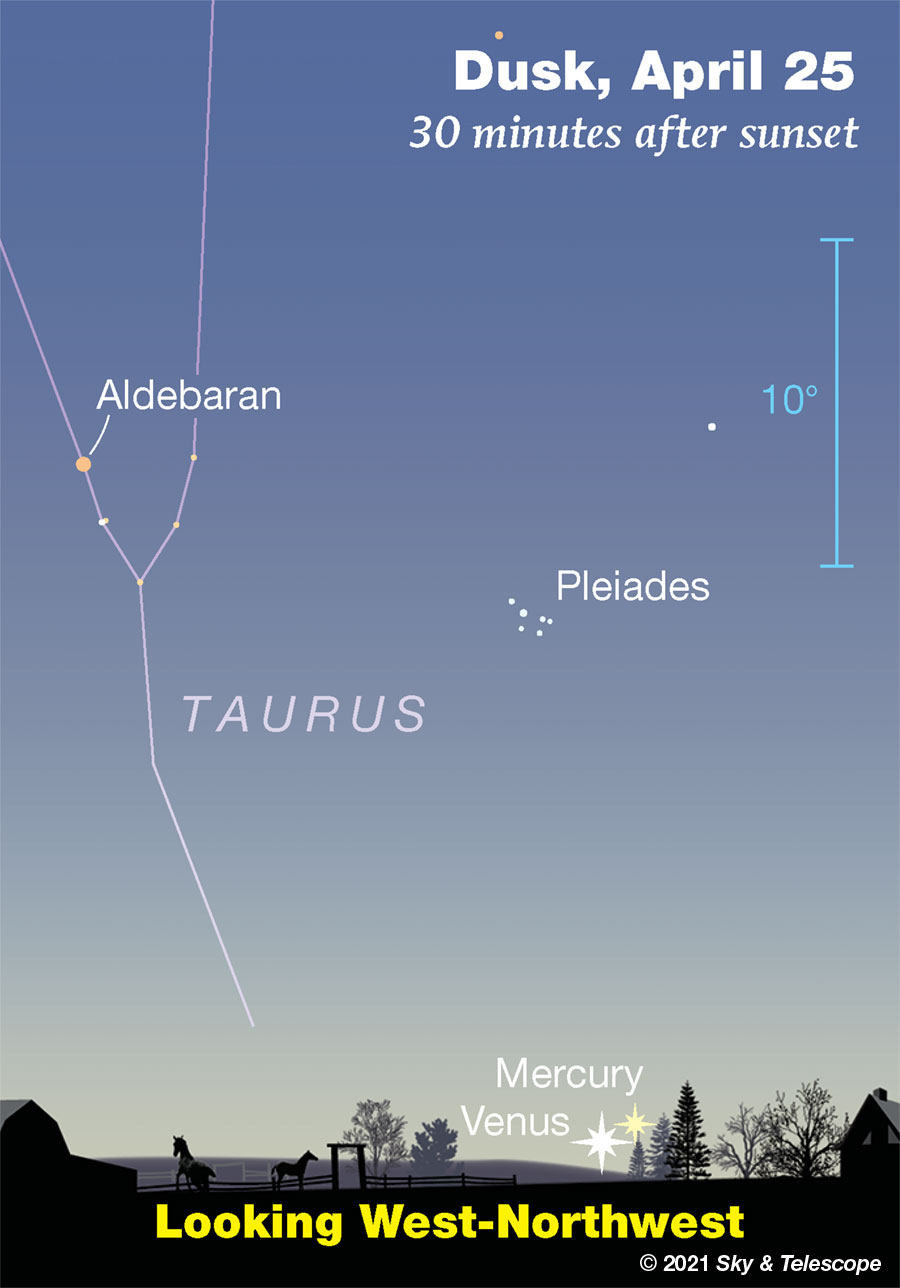
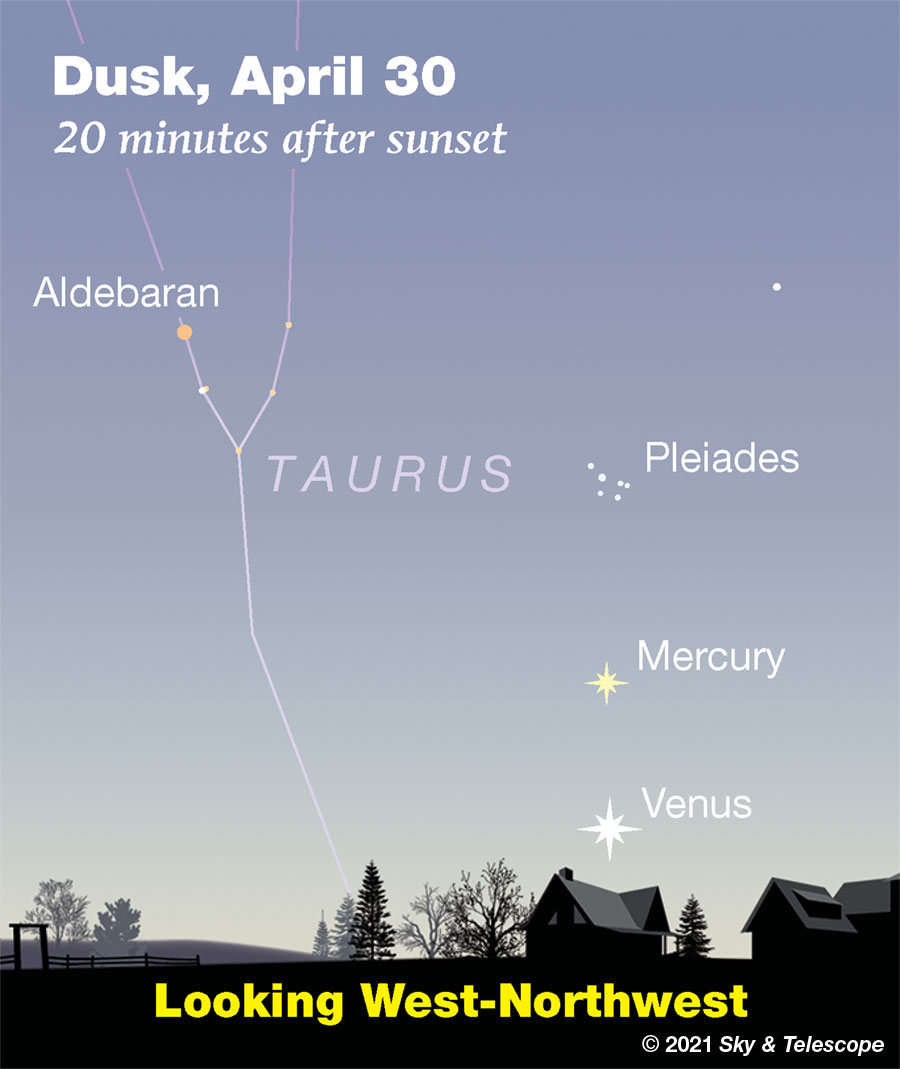
These scenes are drawn for latitude 40° north. That's where Mercury and Venus will appear lined up vertically as shown here on April 30th. At different latitudes, you'll find them tilted by about the same angle that your latitude differs from 40°.
■ The Arch of Spring. As night descends, look very high in the west for Pollux and Castor lined up almost horizontally (depending on your latitude). These two stars, the heads of the Gemini twins, form the top of the enormous Arch of Spring. To their lower left is Procyon, the left end of the Arch. Farther to their lower right is the other end, formed by Menkalinan (Beta Aurigae) and then brilliant Capella.
This spring the Arch has an intruder: little Mars. It's not quite halfway from Capella to Procyon and, for most of the week, a little below that line. The whole array sinks in the west through the evening.
■ After dark tonight the Moon shines on the opposite side of the sky. Look upper left of it, by less than fist at arm's length, for 2nd-magnitude Denebola, the tail star of Leo.
Nearly four fists left or lower left of the Moon shines brighter Arcturus, magnitude 0, the leading light of Bootes.
SATURDAY, APRIL 24
■ This evening Arcturus shines about three fists left of the Moon.
And look below the Moon by hardly more than half that distance, and perhaps a bit left, to find Spica, the brightest star of Virgo.
SUNDAY, APRIL 25
■ Look to the lower right of the Moon, by about 6°, for Spica.
Several times farther to their upper left shines brighter Arcturus.
And Vega, the Summer Star — the zero-magnitude equal of Arcturus — is now twinkling low in the northeast after nightfall. . . depending on your latitude. The farther north you are the higher it will be. If you're in the latitudes of the southern US, you'll have to wait until a bit later after dark for it to appear.
MONDAY, APRIL 26
■ Spot little Mars in the feet of Gemini nearly due west after dark. Find it a bit less than halfway from Capella to Procyon and, for most of this week, a little lower.
This evening use a telescope (what with the bright moonlight!) to look for the open cluster M35 just ½° to Mars's left.
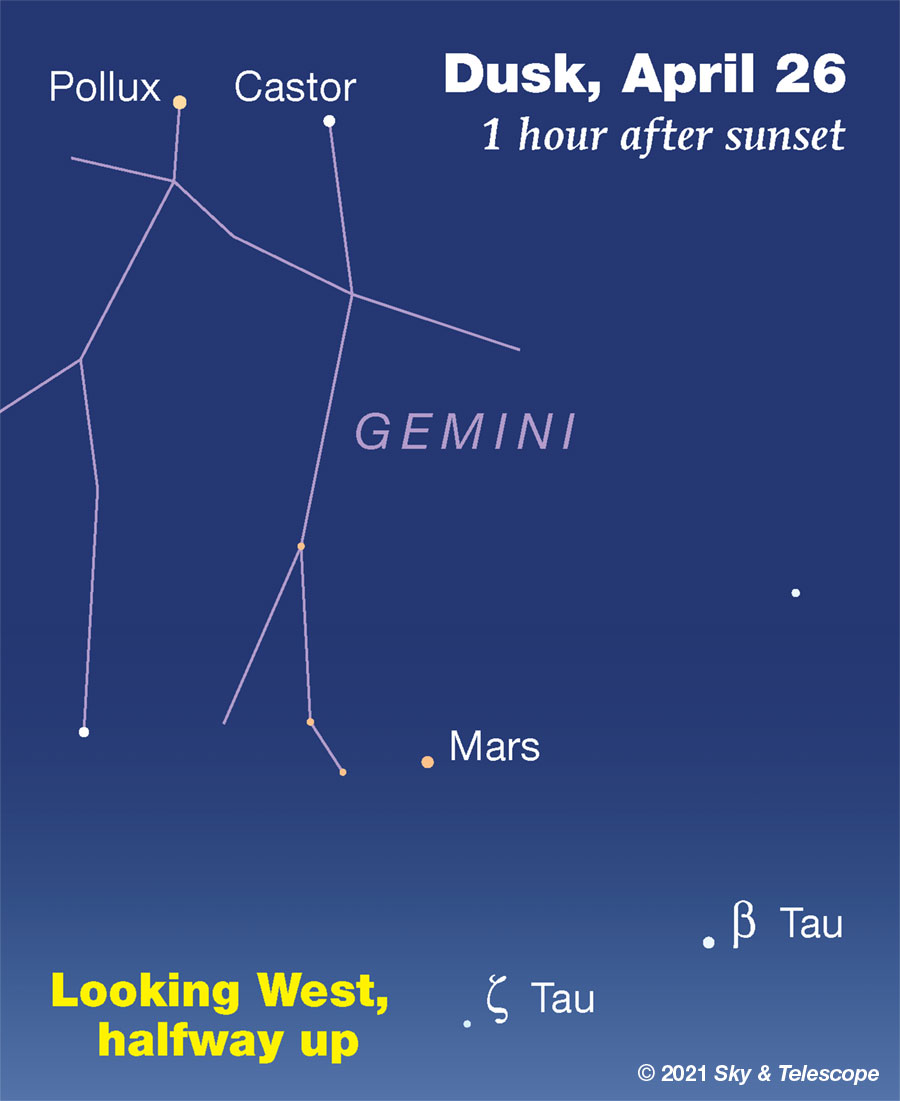
■ Full Moon (exact at 11:32 p.m. EDT). The Moon shines in Virgo, with Spica a few degrees to its lower right and brighter Arcturus much farther to its upper left.
TUESDAY, APRIL 27
■ This evening M35 is ¾° below or lower left of Mars. The moonlight remains bright.
WEDNESDAY, APRIL 28
Now you've got a dark-sky window of about a half hour between the end of twilight and moonrise (depending on your latitude) to see M35 free of moonlight in all its glory. It's now 1.1° below Mars.
■ By midnight tonight the waning gibbous Moon is up in the southeast. Orange Antares is about 4° to its lower right. How much else of upper Scorpius can you see to the right of the Moon?
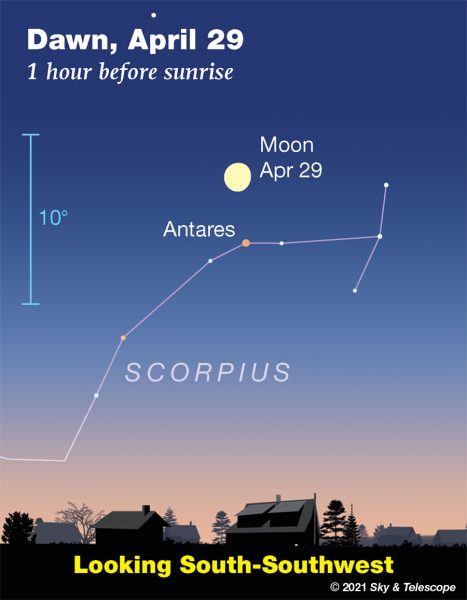
THURSDAY, APRIL 29
■ Face north just after nightfall, look very high, and you'll find the Pointers, the end stars of the Big Dipper's bowl, on the meridian pointing toward Polaris straight down below. From the Pointers to Polaris is about three fists at arm's length.
FRIDAY, APRIL 30
■ Arcturus is the brightest star high in the east these evenings. Spica shines lower right of it by about three fists at arm's length. To the right of Spica by half that distance is the distinctive four-star constellation of Corvus, the springtime Crow.
SATURDAY, MAY 1
■ Even though May has begun, wintry Sirius still twinkles very low in the west-southwest at the end of twilight. It sets soon after. How much longer into the spring can you keep Sirius in view? In other words, what will be its date of "heliacal setting" as seen by you? The farther north you are, the sooner Sirius is gone for the season.
This Week's Planet Roundup
Mercury and Venus begin emerging together from deep in the sunset. Reader Tony on northerly Vancouver Island (latitude about 48° N) called Venus "easy" in 16
Start looking as early as 15 minutes after sunset to catch their brief window of visibility between when the sky is too bright and the planets get too low and disappear into the atmospheric extinction. The exact best time after sunset will depend on your latitude (the farther north the better) and the clarity of the air.
Both planets are a little higher and easier each evening, Mercury especially. By Friday the 30th, Mercury stands 4.5° above Venus. Venus will maintain its brightness, but Mercury by then will be down to magnitude –1.1.
Mars (magnitude +1.5, in Gemini at the feel of the Castor figure) glows in the west after dark. It's a little less than halfway from Capella to Procyon and, for most of the week, a bit below that line. In a telescope it's a mere 5 arcseconds wide: just a tiny shimmering blob.
Jupiter and Saturn (at dim Capricornus) rise more than an hour before the first light of dawn. As dawn begins, spot them low in the southeast. Jupiter grabs the eye at magnitude –2.2. Saturn is 15° to Jupiter's right or upper right, one fifteenth as bright at magnitude +0.7.
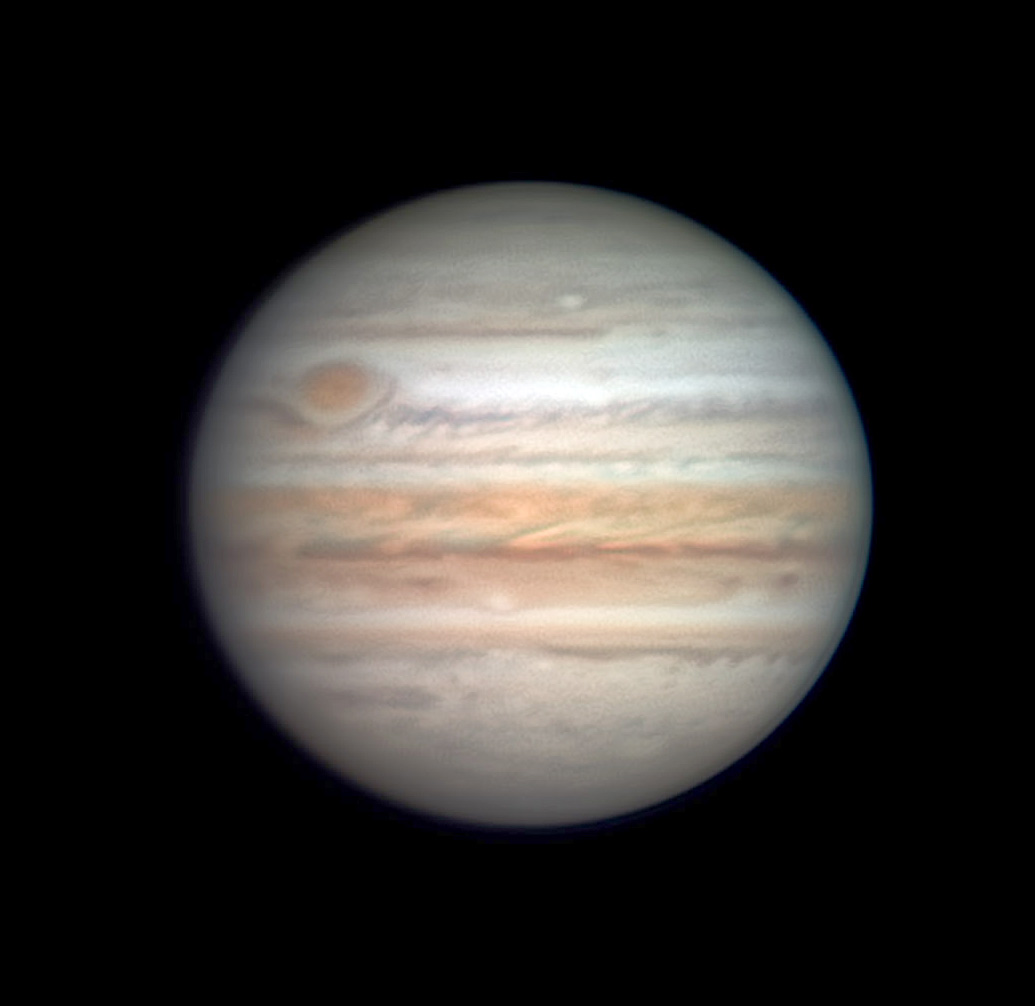
The South Equatorial Belt following (right of) the Red Spot is unusually pale. The Equatorial Zone continues to show complex tan patterns across its northern two-thirds, and the south edge of the North Equatorial Belt is dark red.
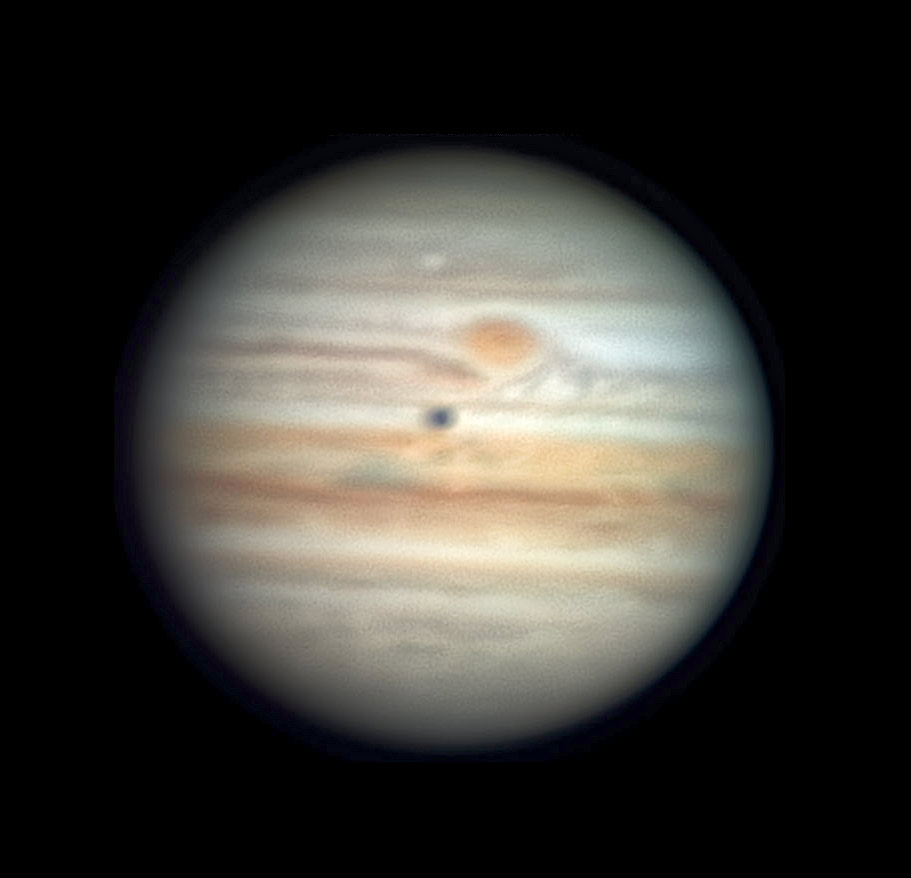
Uranus and Neptune are hidden in the glare of the Sun.
All descriptions that relate to your horizon — including the words up, down, right, and left — are written for the world's mid-northern latitudes. Descriptions that also depend on longitude (mainly Moon positions) are for North America.
Eastern Daylight Time, EDT, is Universal Time minus 4 hours. Universal Time is also known as UT, UTC, GMT, or Z time. To become more expert about time systems than 99% of the people you'll ever meet, see our compact article Time and the Amateur Astronomer.
Want to become a better astronomer? Learn your way around the constellations. They're the key to locating everything fainter and deeper to hunt with binoculars or a telescope.
This is an outdoor nature hobby. For an easy-to-use constellation guide covering the whole evening sky, use the big monthly map in the center of each issue of Sky & Telescope, the essential magazine of astronomy.
Once you get a telescope, to put it to good use you'll need a detailed, large-scale sky atlas (set of charts). The basic standard is the Pocket Sky Atlas (in either the original or Jumbo Edition), which shows stars to magnitude 7.6.

Next up is the larger and deeper Sky Atlas 2000.0, plotting stars to magnitude 8.5; nearly three times as many. The next up, once you know your way around, are the even larger Interstellarum atlas (stars to magnitude 9.5) or Uranometria 2000.0 (stars to magnitude 9.75). And be sure to read how to use sky charts with a telescope.
You'll also want a good deep-sky guidebook, such as Sky Atlas 2000.0 Companion by Strong and Sinnott, or the bigger (and illustrated) Night Sky Observer's Guide by Kepple and Sanner.
Can a computerized telescope replace charts? Not for beginners, I don't think, and not on mounts and tripods that are less than top-quality mechanically, meaning heavy and expensive. And as Terence Dickinson and Alan Dyer say in their Backyard Astronomer's Guide, "A full appreciation of the universe cannot come without developing the skills to find things in the sky and understanding how the sky works. This knowledge comes only by spending time under the stars with star maps in hand."
![]() Audio sky tour. Out under the evening sky with your
Audio sky tour. Out under the evening sky with your
earbuds in place, listen to Kelly Beatty's monthly
podcast tour of the heavens above. It's free.
"The dangers of not thinking clearly are much greater now than ever before. It's not that there's something new in our way of thinking, it's that credulous and confused thinking can be much more lethal in ways it was never before."
— Carl Sagan, 1996
"Facts are stubborn things."
— John Adams, 1770
 1
1









Comments
Rod
April 26, 2021 at 10:38 pm
mary beth, New Jersey Eclipse Fan et al. A great evening out viewing Mars and M35 pair tonight using my 10-inch telescope. 34x to 86x views worked well and at 86x, I could just see Mars as small planetary disk shape (no surface details). Full Moon at 0332 UT 27-April or 2332 EDT tonight. The 10-inch views would make for some excellent photos for the pair 🙂 Sky clear with temperature 10C, I setup at 1930 EDT and finished viewing after 2130 EDT. Sunset near 1954 EDT. By 2045 EDT, the rising Moon cast moonlight all over the pastures and fields. *I see a bad moon a rising. I see Mars up in the sky. Do go out tonight, Mars is in Gemini, M35 is nearby* 🙂
You must be logged in to post a comment.
You must be logged in to post a comment.